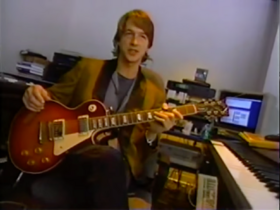Sega Technical Institute
From Sega Retro

|
| Sega Technical Institute Division of Sega of America |
|---|
| Founded: 1990-01 |
| Defunct: 1996 |
| Merged into: Sega of America |
| Headquarters: |
This short article is in need of work. You can help Sega Retro by adding to it.
Sega Technical Institute (STI) was a video game development division of Sega of America which produced a number of the company's first-party video games during the first half of the 1990s. It is notable for producing the Sega Mega Drive's top selling game, Sonic the Hedgehog 2, along with its sequel, Sonic the Hedgehog 3 and others such as Sonic the Hedgehog Spinball, Comix Zone, Kid Chameleon and The Ooze.
In early 1996, the division established a satellite office headquartered in Burbank, California named STI Burbank, responsible for the unreleased Saturn games Comix Zone and Sonic Saturn.
Contents
History

STI was established by Mark Cerny as a development division within the offices of Sega of America with the goal of producing high quality video games in the United States. It was conceived almost as a training facility[2], in which experienced Japanese staff would fly over to train American developers, many of whom had no prior experience in games[4]. However, the plan backfired, initially with delays in sorting out the correct work visas (meaning the Americans were ready, making games before the Japanese had left the country). As a result of this, STI's first product, Dick Tracy was built by a wholly American team.
After the release of Sonic the Hedgehog, lead programmer Yuji Naka briefly left Sega, but after the game proved popular, was convinced by Cerny to travel to the US to begin work on a sequel, Sonic the Hedgehog 2. Naka, alongside other Japanese staff (including core "Sonic Team" member Hirokazu Yasuhara) became members of STI and began the project in conjunction with US staff, however severe language and cultural barriers effectively drove STI into two distinct teams after its release[4][2][5], with the parties acknowledging that Sonic 3 would be better served by a Japanese-only team. Cerny also left STI after Sonic 2.
The American developers continued on their own projects, namely Sonic the Hedgehog Spinball and later Comix Zone and The Ooze. After the release of Sonic 3 and Sonic & Knuckles, many of the Japanese developers returned to Japan, and Sega of America took full control of STI. STI would work with the Japanese Sega AM1 division in creating Die Hard Arcade, but following corporate shake-ups, would become "Sega of America Product Development"[6], managing external development and localising games for the US market. During this period, several of its original products were scrapped. The creative control at STI meant several projects were started but unfinished, the most notable being the infamous Sonic X-treme, a widely-publicised 3D Sonic the Hedgehog game destined for the Sega Saturn.
Years after its closure, a number of former Sega Technical Institute staff (such as Hirokazu Yasuhara) would later migrate to developer Naughty Dog, working on titles such as the Jak & Daxter series and Uncharted.
Softography
Sega Titan Video
- Die Hard Arcade (1996)
Arcade
- Tornado (unreleased)
Master System
- Dick Tracy (1991)
Mega Drive
- Dick Tracy (1991)
- Greendog: The Beached Surfer Dude! (1992)
- Sonic the Hedgehog 2 (1992)
- Kid Chameleon (1992)
- Sonic the Hedgehog Spinball (1993)
- Comix Zone (1995)
- The Ooze (1995)
- Astropede (unreleased)
- Dark Empires (unreleased)
- Jester (unreleased)
- Sonic-16 (unreleased)
- SpellCaster (unreleased)
- Spinny & Spike (unreleased)
- Treasure Tails (unreleased)
Game Gear
32X
- Mars Sample Program (unreleased)
- Sonic Mars (unreleased)
Saturn
- Die Hard Arcade (1997)
- Sonic X-treme (unreleased)
Windows PC
- Sonic X-treme (unreleased)
List of staff
- Alan Ackerman
- Ofer Alon
- Hiroshi Ando
- Takahiro Anto
- Kunitake Aoki
- Tsuneko Aoki
- Jamie Bible
- Mark Cerny
- Scott Chandler
- Fei Cheng
- Christina Coffin
- Betty Cunningham
- Howard Drossin
- John Duggan
- Chris Ebert
- Don Goddard
- Manny Granillo
- Takahiro Hamano
- Ross Harris
- Roger Hector
- Stieg Hedlund
- Takashi Iizuka
- Michael Kosaka
- Tatsuto Kumada
- Mark Kupper
- Dean Lester
- Broderick Macaraeg
- Peter Morawiec
- Robert Morgan
- Toshiyasu Morita
- Yuji Naka
- Alex Niño
- Shigeru Okada
- Tom Payne
- Jason Plumb
- Andrew Probert
- Ken Rose
- Brenda Ross
- Dean Ruggles
- Dave Sanner
- Chris Senn
- Robert Steele
- Adrian Stephens
- Craig Stitt
- Earl Stratton
- Yutaka Sugano
- Marti Thompson
- Makoto Uchida
- Mike Wallis
- Richard Wheeler
- Bill Willis
- Steve Woita
- Yasushi Yamaguchi
- Masanobu Yamamoto
- Hirokazu Yasuhara
- Takashi Yuda
- Tony De Zuniga
External links
- Developer's Den: Sega Technical Institute article by Ken Horowitz at Sega-16
- The Unique History of the Sega Technical Institute article by Kevin Tihon at Cartridge Thunder
- Sega Technical Institute - the history & the games article by Damiano Gerli at The Genesis Temple
References
- ↑ 2.0 2.1 2.2 Interview: Peter Morawiec (2007-04-20) by Sega-16 Cite error: Invalid
<ref>tag; name "Interview: Peter Morawiec (2007-04-20) by Sega-16" defined multiple times with different content - ↑ 3.0 3.1 http://www.lostlevels.org/200403/timeline.shtml (Wayback Machine: 2023-06-21 01:35)
- ↑ 4.0 4.1 Interview: Mark Cerny (2006-12-05) by Sega-16
- ↑ https://www.thesegalounge.com/117-howarddrossin1/
- ↑ Interview: Mike Wallis (2007-06-19) by Sega-16
| Timeline of Sega of America research and development divisions |
|---|
|
86
87
88
89
90
91
92
93
94
95
96
97
98
99
00
01
02
03
04
05
06
07
08
09
10
11
12
13
14
15
16
17
18
19
20
21
22
23
|